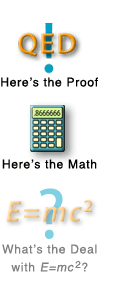
|

|

|
The most famous equation in the history of science, Einstein’s “energy ( E ) equals mass ( m ) times the speed of light ( c ) squared” changed our view of matter and energy—and consequently changed our fundamental understanding of the universe. Rather than seeing mass and energy as separate things, we now see them as different aspects of a single thing: You can think of mass as a particular kind of energy that can be converted into other kinds of energy such as heat, light, and motion. The equation E = mc 2 describes matter at rest. (A more complicated version of the equation includes matter in motion.) Essentially, it says that the mass of an object at rest can be converted to energy, and energy can be converted to the rest mass of an object. To find out exactly how much energy an object at rest contains, we multiply the mass by c 2 . Because mass is measured in kilograms and energy is measured in joules, c 2 is used as a conversion factor so that the energy of the object can be expressed in joules. (If scientists long ago had understood the equivalence of mass and energy, we would undoubtedly use the same unit for both.) You may wonder why the conversion factor involves the speed of light. It may help to think of c —299 792 kilometers per second—as the “ultimate speed limit” of the universe, which makes it a very basic number in special relativity that affects far more than the speed of light. Einstein didn’t pluck c 2 out of the air, though. He did some complicated mathematics to work it out. Einstein thought that the mass-energy equation was the most important outcome of special relativity—even though, in the early 1900s, there was no way to test it. In fact, it wasn’t demonstrated experimentally until 1932. Today we know that mass-energy conversions take place inside our sun, in nuclear power plants, in particle accelerators, and in a host of other processes, and we can easily measure all but the smallest conversions. Try this! You’ve probably heard the saying that, in terms of the chemicals in your body, you’re worth only a few U.S. dollars. But how much are you worth in terms of energy? Use the calculator to find out how much energy is stored in the mass of your body—and its value, based on the price of electricity.
If you don't know how many kilograms your mass is, you can divide your weight in pounds by 2.2 to find out. Mass and weight are different quantities, but they're directly proportional, so we can convert from one to the other. At the surface of Earth, an object with the mass of 1 kilogram weighs 2.2 pounds.
Home | Time | Length | Mass | Fuel | Spaceship | Thinking Like Einstein
© Exploratorium | Credits
|

|
|
|||||||||
|
|
||||||||||||